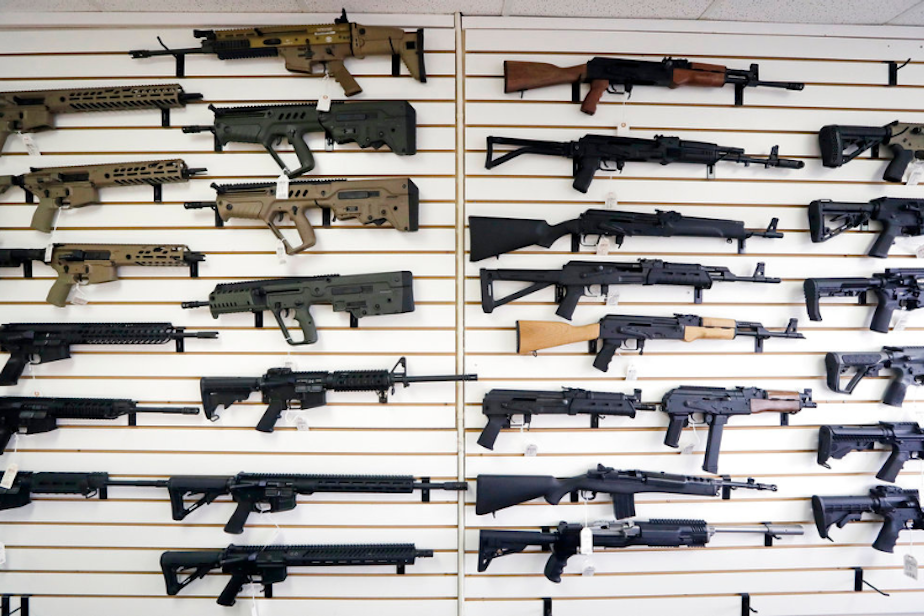Should we think of gun violence as a 'disease'? These epidemiologists do

Epidemiologists study diseases — the ways they spread and how we can combat them. It’s all in the interest of protecting public health. Now, more epidemiologists will be studying the many health impacts of gun violence.
For the first time ever, the Springer Handbook of Epidemiology has added gun violence to its pages. How does looking at gun violence as a disease change the way we view it?
A
li Rowhani-Rahbar is a professor and Julia Schleimer is a PhD candidate at the University of Washington’s Department of Epidemiology. Together, they co-authored the inaugural chapter on gun violence for the Springer Handbook of Epidemiology.
"About 250,000 people die each year due to firearm-related injury," Rowhani-Rahbar said. "In the United States, about 45,000 to 50,000 people die each year. So a fair share of those deaths are actually here in the United States."
Throughout the co-authored chapter, which was published last December, Rowhani-Rahbar and Schleimer examine what data shows are the largest determinants for gun violence on a global scale. Those risk factors are then analyzed at the individual, family, community, and societal levels, respectively.
Exposure to violence in one's home or community, as well as various social and economic inequities are risk factors for gun violence, Schleimer said.
Sponsored
"At the societal level, there's also — broadly — norms and culture that likely contribute in some way, either directly or indirectly," she added.
The two researchers found that of the countries with the highest gun violence rates, the United States is the wealthiest.
"When we think about the overall rates of violence, and different forms of violence, and we compare United States with other high-income countries, we're actually not on top of the list — we're sort of in the middle of the pack," Rowhani-Rahbar explained. "But when it comes to lethal violence...when we talk about firearm related violence, by far, the United States is an outlier compared to many other high income countries."
He pointed out that the constitutional right to bear arms is a unique factor when it comes to gun violence in the U.S., adding that many Americans have grown up in families or communities that embrace gun ownership.
"The point here is how we could reduce the risk of harm, including injury and crime, by smart policies and strategies that reduce that risk or misuse of [guns]," Rowhani-Rahbar said. "We, by some of the best estimates, have anywhere between 350 to 400 million firearms in civilian use here in this country."
Sponsored
A significant number of those firearms reside right here in the Pacific Northwest, according to the RAND Corporation, a non-partisan, nonprofit research organization specializing in policy recommendations, including those related to gun violence. RAND published a database in 2020 ranking Idaho, Alaska, Montana, and Wyoming among the top four states for gun ownership in the U.S.
That reality may defy stereotypes about where guns are most prevalent, Rowhani-Rahbar said, adding that the issue of gun violence is multidimensional.
"Whenever we talk about gun violence, for many people, their mind quickly goes to assault, interpersonal violence, people killing each other. We forget sometimes that we have a huge problem of suicide in this country. And in fact, the majority of gun-related deaths — let's say here in Washington — are suicide."
In any case, Rowhani-Rahbar said the common denominator is the availability and accessibility of firearms. The chapter he and Schleimer wrote is dense, with more than 50 pages citing studies by various researchers and institutions, examining the efficacy of gun policies like minimum age requirements and background checks for purchasing firearms.
In instances of gun-related suicides, Schleimer said mental illness is a strong risk factor. But when it comes to interpersonal violence, like mass shootings, mental illness isn't as much of a determinant.
Sponsored
"Estimates suggest that about 4% of interpersonal violence is attributable to mental illness," she said. "Much more of the risk — the vast majority — is attributable to...personality traits or behaviors such as anger, aggression, impulsivity, and substance use."
Listen to the full conversation with Soundside by clicking "play" on the audio above.





